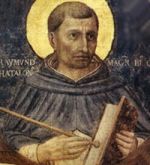The Shrine Built By the Poorest
by Zsolt Aradi
Many of the pictures of Our Lady are great works of art, painted by famous artists. Some statues have strange and curious histories, due to the scene of their discovery, the unusual circumstances attending that discovery, or because of the extraordinary materials of which they are made. There are Madonna figures of ivory, ebony and gold; many of these images are laden with diamonds and other precious jewels. But Bartolo Longo, an Italian peasant who wanted to erect a little sanctuary to the Holy Virgin, at Pompeii, had no money at all, and he knew that his fellow peasants were also without means. So a fund-raising campaign would have had little result.
The year was 1872, the scene Naples and its vicinity. Bartolo heard a voice telling him that he should say the rosary and ask others to do so. He knew that in order to establish a so-called confraternity where they could pray together, the group should possess an image of the Blessed Virgin. Bartolo decided not to wait until the time when he might be able to get together sufficient funds; he went to a Naples junk shop and bought a picture of Our Lady, which cost less than a dollar. The picture was insignificant, its author unknown, the Blessed Virgin and the Holy Child were shown giving a rosary to St. Dominic and St. Catherine of Sienna. In addition to its rather nondescript appearance, there was a large hole in the canvas. When Bartolo returned to Pompeii with his picture (he had traveled on a refuse cart because no one else wanted to give him a ride), his friends, the future fellow-members of the confraternity, turned up their noses at the picture and angrily refused to accept it as the official image of their circle.
That happened in 1872. Today in Pompeii stands a lovely Basilica and about a million pilgrims visit the shrine yearly. Sometimes as many as one hundred masses are celebrated each morning inside the Basilica. More than eighty priests are needed to hear the confessions.
The present Basilica was started in 1934 but before its erection Bartolo Longo built a church and also an orphanage for more than one thousand girls. He created a printing, cabinet making and leather workshop, for the neglected sons of criminal prisoners, and he even embellished the painting he had found in a Naples junk shop. As the fame of his little sanctuary grew, a well-known Neapolitan painter restored it. This image is now one of the loveliest Madonna pictures in Italy.
The significance of the Pompeii shrine is enormous; it is one of those centers, which, through invisible threads, reveals the social message of the Gospel. There are few regions of Europe, which have been so poverty-stricken over the centuries as the provinces of southern Italy. This sanctuary has sprung entirely from the hearts of the people of the province of Naples. The Basilica was built with their pennies and, miraculously, it helps them oppressive burden of a seemingly hopeless poverty.
This item 3047 digitally provided courtesy of CatholicCulture.org






